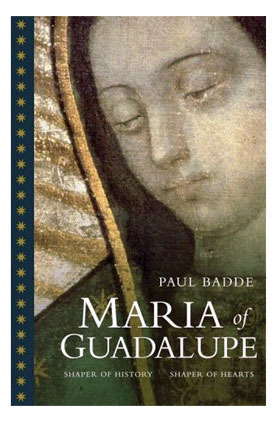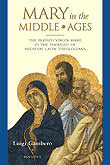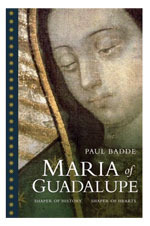Chapter One of "María of Guadalupe: Shaper of History, Shaper of Hearts"

A Delectable Fruit of the Cactus for the Eagle | Paul Badde | Chapter One of
María of Guadalupe: Shaper of History, Shaper of Hearts
With wood from the Santa Marla, Christopher Columbus built the first
house in America. Hernán Cortés conquered Mexico. The growling of dogs on the
beach and the dawn of the modern era lie heavy over the cities of New World and
Old.
On the morning of August 3, 1492, sails
billowing in the first wind, Columbus sailed from Andalusia in the Santa
María, together with the Niña and the Pinta, in order, as he confides in the ship's log, to search for a westerly
sea route to Jerusalem. If the names of his ships had been listed in another

way, they would have made the phrase "Holy Mary (Santa María) paints (pinta) the girl (niña)". In
itself, this would have been striking. However, this was only the beginning of
the incredible story of the dark Lady, who, five hundred years after the
discovery of America, still waits to be discovered by Europe, Asia, Africa and
other parts of the world.
Historians say that, on Christmas night, 1492, the Santa María ran aground on a sandbar off of Haiti. Columbus
decided to dismantle the grounded flagship and "build a fort out of what
was salvaged". However, some years ago on the docks of the port of Barcelona,
I saw an exact reproduction of the caravel Santa María. I doubt that with the planks and masts of this
nutshell anyone could have managed to construct a fort. Two or three huts,
perhaps, or a house—or even a small barricaded chapel. There was not
enough material for more. The one thing that seems sure is that from the
remains of the Santa María the
first European house was raised in the New World. A year later it was pulled
down and reduced to ashes.
Twenty-seven years later Hernán Cortés, a native of the city of Medellin, in
Spain, disembarked from the Santa María de la Concepción onto the shore of the American continent. It was Good
Friday of 1519, in the area of what would later become the port of Veracruz. A
small expeditionary flotilla accompanied the Santa María de la
Concepción . Two days later, Cortés asked
two Franciscans, Diaz and Olmedo, to celebrate Easter with a high Mass on the
beach. "The Spaniards planted a cross in the sandy ground", writes
Francisco López de Gómara in his history of the conquest of Mexico. "They
prayed the rosary and the Angelus as a bell was rung." To anyone familiar
with Catholic liturgy, this seems somewhat confused. But there is no doubt
that, after the liturgical service, Cortés, in a brief speech, took possession
of an immense territory in the name of the Spanish Crown. Needless to say, the
king of Castile was totally ignorant of who Cortés was and what he was doing
there. The "Captain General" had taken on himself the responsibility
of a royal commission.
Thus he resembled the immortal Don Quixote de la Mancha, who in Cervantes'
book, written years later, would assume the fight against the forces of evil
and defend the honor of the pure and lovable Dulcinea, who unfortunately
existed only in the poor knight's addled brain and overheated imagination. But,
unlike Don Quixote, "the Knight of the Woeful Countenance" with his
nag Rocinante and his rusty lance, Cortés set upon his mission with a sharp
sword and well-fed horses. Hernán Cortés' countenance was by no means woeful;
he was an elegant man who dressed in silk and velvet . The natives could not
comprehend what he might represent, and they observed in wonder the solemn
ceremony of the occupation of Mexico. They were baffled as they observed these
pale, well-armed men bow their heads and kneel before a wooden cross.
Along the coast, next to the conqueror's flagship, were anchored three other
caravels and six small brigatines that had transported 530 men in the prime of
their lives. They were natives of Spain, Genoa, Naples, Portugal and France.
Among them were fifty sailors, the two Franciscans already mentioned, thirty
crossbow-men and twelve harquebusmen. Among their armaments the expeditionary
force had many swords and lances, sixteen horses, numerous Irish wolfhounds and
mastiffs, ten long-range cannons, four falconets and various small Lombard
cannons, as the new firearms were named in those days. Some of the men had
mutilated ears—the punishment for those who had been caught robbing and
convicted in Castile. Be that as it may, the gold chain around the neck of the
self-proclaimed Captain General Cortés bore a medal with the Virgin Mary on the
front and Saint John the Baptist on the back. On the mainmast of the flagship
waved a golden pennant with a blue cross and the Latin inscription:
"Amici, sequamur crucem, et si nos fidem habemus, vere in hoc signo
vincemus": Friends, let us follow the cross . If we believe in it, truly
in this sign we will conquer.
In spite of everything, a few weeks later, some of the conquistadors no longer
held such a belief and had lost faith in the leader's good luck; they mutinied
and took over a brigantine in order to sail back to Cuba. Cortés hanged two of
the ringleaders, mutilated the foot of a third and had the rest publicly
flogged. Then he gave orders that, with the whole expeditionary force looking
on, nine ships should be grounded in the bay of Villa Rica, in order that even
the most cowardly among them would have only one way open, through all their
fears: the road to Tenochtitlan, the Aztec capital. In those days it was as
large and as populated as ancient Naples or Constantinople and was even more
beautiful than Venice. Cortés left only one ship in navigable condition, the Santa
María de la Concepción. As all of this was
going on, in far-away Europe Leonardo da Vinci was dying and the seven German
electors were electing Charles I of Castile as Charles V of that Holy Roman
Empire over which, it would later be said, the sun never set. With the addition
of Mexico and the Philippines, this empire would cover the globe.
Within a mere two years of disembarking, Cortés had conquered the mighty Aztec
empire. According to one variant, the word "Mexico" meant the
"Land of the Moon". An actual conquest of the moon would not have come
as a greater surprise. Nothing could have prepared the Europeans for the
discovery of a New World or for the natives, whose human sacrifices terrified
and revolted the Spanish adventurers from the first moment they witnessed the
Aztecs take a flint knife to carve out the heart of a living victim and place
it, still beating, on a black basalt altar as an offering to their god
Quetzalcóatl. They called this the "delectable fruit of the cactus for the
Eagle". Some of these altars of sacrifice to the Eagle still exist. After
the conquest of Mexico, for example, the architects of the royal chapel nearby
in Cholula imported them as holy-water fonts for the entryway.
Generally, before the sacrifice of members of the aristocracy, a drink of
hallucinogenic mushrooms and a ration of obsidian wine would be given
them—something, however, not disdained by many of the onlookers as well,
whose deafening roars of laughter echoed unforgettably through the Spaniards'
heads day and night. Less aristocratic or reluctant victims received nothing
and were dragged up the pyramid by the hair. Because the priests drew blood
from their own ear lobes as additional sacrifices, they were sinister-looking
indeed. This was not all. They dressed in black; their hair was tangled; their faces
ash-gray; their fingernails extravagantly long. Nothing could reconcile the
Spaniards to Aztec sacrificial practices: not gold, not plaintive chants, not
the gorgeous feathered vestments, not even the legendary magnificence of the
Aztec cities. The blood-encrusted temple pyramids seemed to the Spaniards the
very portals of hell.
In turn, to the Aztecs, the Spaniards' horses, which they called deer, seemed
"as tall as the rooftops". The Spaniards entertained themselves by
terrorizing the people with the horses' neighing, which they used tactically
and strategically. This was a clash of cultures for which there was no
precedent: Stone Age versus Iron Age; obsidian and flint versus Toledo steel;
hauling by sled or teams versus the wheel; arrows versus gunpowder and
cannonballs; and finally, the recklessly bold spirit of these Renaissance
Christians versus the proverbial pagan anguish of the Amerindians, who were
subject to an uncountable multitude of gods.










During the conquest of Mexico, from among the 1600 Spaniards, mostly latecomers
to Cortés and his expedition, about one thousand died. But the Amerindian
tribes who joined the conquistadors—the Tlaxcaltecans, for example, whom
the Spaniards stirred up and set against the tyrannical Aztec people—mourned
many more victims. The historian Hugh Thomas concludes about their combatants
and victims as a whole that the Aztecs "had fought like gods" in the
struggle but, in such an unequal contest, had perished by the hundreds of
thousands. There had been prophecies that, in the year 1519, Quetzalcóatl,
their feathered serpent-god, would return. The Aztecs had been waiting for him
for generations. For this reason, some suppose that the Aztecs succumbed, not
so much because of Spanish astuteness and their superior war machine, but
rather because of an overwhelming surprise—and a profound disappointment.
Before and after the conquest of Mexico, not a single native Amerindian living
on the islands of the Caribbean survived the Spanish invasion. For this reason,
after their land was conquered, the situation seemed equally hopeless to the
inhabitants of Mexico—Mexican, Mistecan, Cholulan, Toltecan, Chichimecan,
Tlaxcaltecan, Xochimilcan, Totonacan and others. From here on we will refer to
them simply as Aztecs, the name by which the Europeans identified the
Amerindians who held sway over vast territories in Mexico at the time of the
conquest. First, obviously, no dialogue between the cultures was likely to have
been successful, even before the final victory of the military expedition,
after Cortés kept the powerful ruler of Mexico, Montezuma II, under arrest in
his own palace. Before he died under a rain of stones hurled by Aztec hands, a
rain of stones that would erupt like a volcano against the Spaniards from their
capital—before all this, the adventurer from Spanish Extremadura would
sit for hours at night with the Aztec emperor, who before his accession to the
throne had himself been high priest. He spoke to him not only about his
sovereign, Charles, the sharpest "sword of Christendom" (to whom
Cortés hoped to offer Montezuma's empire as a gift), but also about the
ever-virgin Mother of God; about God: the Father, Son and Holy Spirit; about
the Immaculate Conception; about the Incarnation; and about many other "interesting
things". The sermons of this passionate conquistador and ladies' man were
scarcely less bold than his conquest. This is something that sometimes
surprises his biographers, and they refer to it frequently.
Nevertheless, for the Aztecs these sermons must have sounded more than strange.
For on other days, in the plaza of the Great Pyramid, Cortés permitted the
chained Aztec monarch to preside at the solemn burning of rebel Amerindian
rulers. Montezuma himself did not stop having human sacrifices offered even while
imprisoned. From the apex of the Great Pyramid drums sounded, as did conch
horn, flutes and fifes made from bone. The earth had to keep revolving, and for
this blood was needed. Also the many celebrations had to continue, and these
could not be imagined in ancient Mexico without the human sacrifices that were
"like flowers for the gods". The Aztecs had surrendered to bloodlust.
The Florentine Codex relates that when his daughter reached the age of six or
seven, an Aztec father would say to her: "An obsidian wind is blowing on
us; it brushes us lightly and moves on; the earth is not a place of well-being;
here there is no joy; here there is no happiness." Four hundred years
later, Joseph Hoffner wrote: "A dark and bloody harshness weighed down the
religion, a harshness that had deprived them of any cheerful lightness of
heart." The Aztecs could not imagine life without war.
In the Old World, on the other hand, especially in Spain, not only were many
real or presumptive heretics being burned at the stake, but also, in Germany,
this was the time when the Reformation rose and took its course, which for the
first time broke the Church apart into Catholics and Protestants, so that very
soon eight million Christians had cut themselves off from Rome. No bonfire, no auto-da-fé,
with its flames, could stop this
revolution. In any event, the Emperor Charles V had enough to worry about
without preoccupying himself with the adventures of one of his many foolhardy
subjects in some faraway New World. The dawn of the modern era, with its
attendant terrors, was on the horizon.
Simultaneously something occurred in Mexico that sounds more fantastic than the
most sensational account of the conquest of the Aztec empire by Cortés and his
men. It was the first apparition of the Queen of Heaven in the New World. No
one with any regard for his intelligence would want to put faith in this
phenomenon. Perhaps only now can the scope of this event be truly seen,
because, better than ever before, we can now perceive how greatly this event
has changed the course of history and the balance of the world.
Related IgnatiusInsight.com Articles and Book Excerpts:
• Mary in Byzantine Doctrine and Devotion | Brother John M. Samaha, S.M.
• Fairest Daughter of the Father: On the Solemnity
of the Assumption | Rev. Charles M. Mangan
• The Blessed Virgin in the History of
Christianity | John A. Hardon, S.J.
• "Hail, Full of Grace": Mary, the Mother of Believers |
Joseph Cardinal Ratzinger
• Mary in Feminist Theology: Mother of God or Domesticated Goddess? |
Fr. Manfred Hauke
• Excerpts from The Rosary: Chain of Hope | Fr.
Benedict Groeschel, C.F.R.
• The Past Her Prelude: Marian Imagery in the Old
Testament | Sandra Miesel
• Immaculate
Mary, Matchless in Grace | John Saward
• The Medieval
Mary | The Introduction to Mary in the Middle Ages | by Luigi Gambero
• Misgivings About
Mary | Dr. James Hitchcock
• Born of the Virgin Mary | Paul Claudel
• Assumed Into Mother's
Arms | Carl E. Olson
• The Disciple
Contemplates the Mother | Erasmo Leiva-Merikakis
María of Guadalupe: Shaper of History, Shaper of Hearts

by Paul Badde
Mexico, December 9, 1531. Ten years after the Spaniards conquered this
land, on a hill on the outskirts of the capital, something
inconceivable happens to Juan Diego, a native of the area.
At dawn a heavenly figure comes to meet him, revealing herself as
"Mary, mother of all men". To confirm the first vision, the Lady not
only entrusts him with several messages. But, also, in the
final vision, leaves her portrait mysteriously present on his tilma.
It is the portrait of a young woman looking downward. She is clothed in a
dress figured with roses and a mantle
spangled with stars.
From the time of its occurance this event has moved people. However,
because of the fascination with the image itself, doubts have been
raised, causing some to reject it altogether. This image of
Our Lady of Guadalupe, along with the Shroud of Jesus in Turin, have
possibly become the most mysterious images on earth. The more studies
are made of the image and of the cloth, the more mysterious it
all becomes, for believers and scientists alike.
In a hands-on investigation, Paul Badde has been delving into this
mystery from a historian's point of view, but also with the growing
wonder of a journalist who has stumbled across a fabulous
treasure.
In this heartfelt report, Paul Badde tells the fantastic story of the
apparition that changed the history of the world. Only in light of this
mysterious event, can one explain why the inhabitants of
Central and South American entered the Church so quickly. Mary of
Guadalupe was the person who inserted a whole continent into Western
Culture.
Published on December 12, 2012 09:30
No comments have been added yet.
Carl E. Olson's Blog
- Carl E. Olson's profile
- 20 followers
Carl E. Olson isn't a Goodreads Author
(yet),
but they
do have a blog,
so here are some recent posts imported from
their feed.



